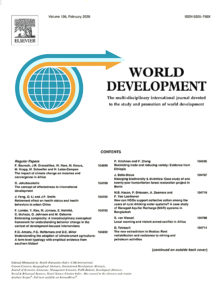Intra-seasonal climate variability and crop diversification strategies in the Peruvian Andes: A word of caution on the sustainability of adaptation to climate change
| Year | : | 2019 |
|---|---|---|
| Author/s | : | Carmen Ponce |
| Area/s | : | Rural development and agriculture |
Ponce, Carmen (2020). Intra-seasonal climate variability and crop diversification strategies in the Peruvian Andes: A word of caution on the sustainability of adaptation to climate change. World Development, 127.
Agricultural systems are highly sensitive to climate change. Most studies focus on the effect of heat and water availability on crop yields, but little is known about the impact of changes in intra-seasonal climate variability (particularly challenging in mountain regions). Also, beyond the effect on crop yields –mostly focused on single cropping systems and major world crops- little analysis has been done on more complex, diversified and low-input cropping systems like those prevalent in the Andean region.
This study investigates whether Andean farmers respond to increasing climate variability by increasing crop diversity (measured by intercropping and crop diversification indices) and by switching to crops which better tolerate heterogeneous environmental conditions. Since previous studies show that crop diversification fosters resilience of agricultural systems, decreasing crop portfolio diversity in an increasingly variable environment may challenge farms sustainability. The data used in the analysis combines district-level socio-economic information from two agrarian censuses (1994 and 2012) with district-level climate estimates of mean temperature, temperature range and precipitation (averages for periods 1964–1994 and 1982–2012).
Based on fixed effects models that allow for sub-region parameter heterogeneity, researcher finds that an increase in intra-seasonal climate variability leads farmers in colder areas (-11 °C during the growing season) to concentrate their portfolio into more tolerant crops and reduce intercropping (a practice potentially efficient at controlling pest and disease). This effect is especially strong in the Southern region (more indigenous, less integrated to markets). These results complement previous studies by providing robust and regionally representative evidence on small-farmers’ nonlinear response to climate variability. Furthermore, given that Andean farmers received little-to-no help to adapt to climate change during the period under analysis, this study informs about farmers’ autonomous adaptation to climate changes and raises concern on current adaptation responses that may hamper agricultural system’s sustainability in the face of climate change.







